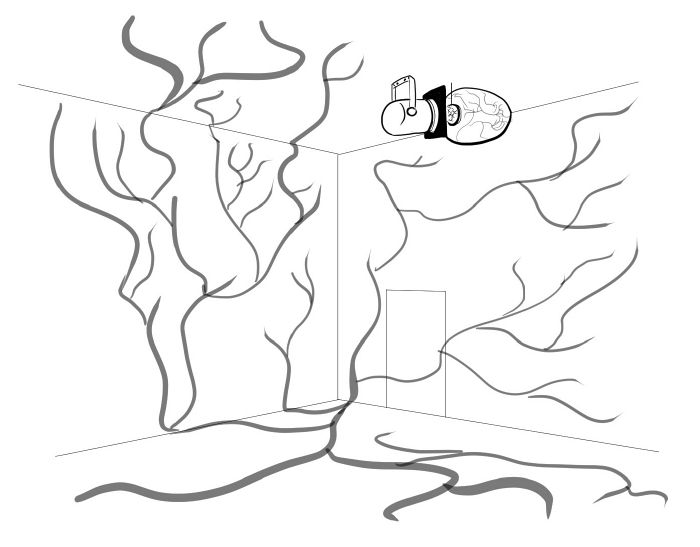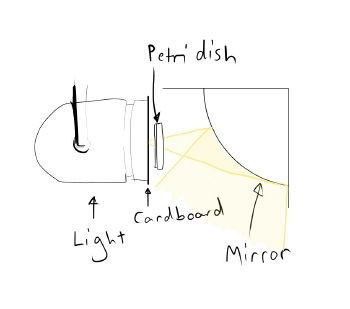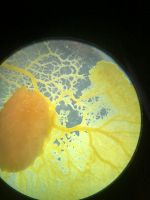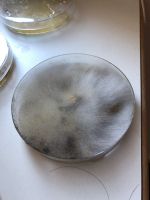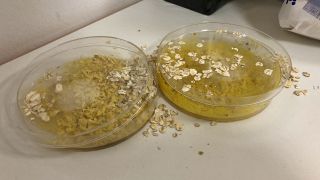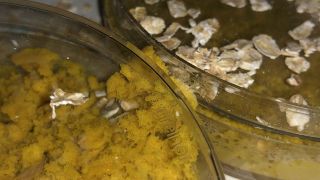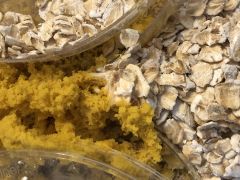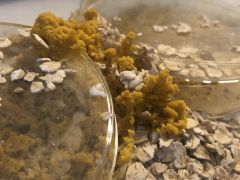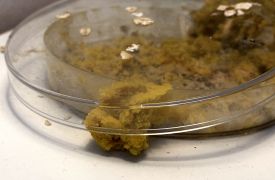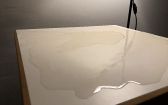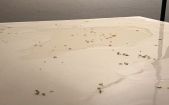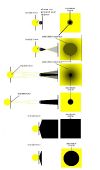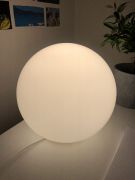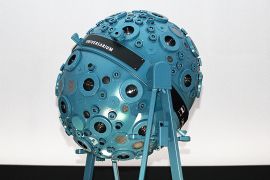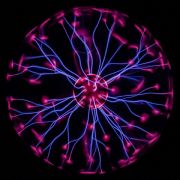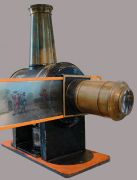No edit summary |
No edit summary |
||
| (52 intermediate revisions by 2 users not shown) | |||
| Line 1: | Line 1: | ||
[[File:Microscopy of Slime Mold.jpg | [[File:Illustration Installation 1.jpeg|700px]] | ||
My first timelapse turned out pretty bad with lots of | |||
Even though the Slime Mold is able to survive in such an incredibly unique way, us humans subconsciously (or consciously) perceive this organism as a being that is ultimately inferior to us. This work breaks this hierarchy in a way. As I was trying to explore ways of reversing the interspecific hierarchical pyramid, I came to the realisation that one of the reasons why humans see unicellular organisms, which are beyond a doubt the most fundamental inhabitants of the earth, inferior to themselves, is because of their size. The installation explores a possible solution to the problem of equalising and maybe even reversing our sizes. | |||
The installation takes place in a relatively spacious room (~25-30 m²). At the center of the room is a spherical mirror "projector", on which the ''Physarum Polycephalum'' is growing. A shadow of the growing Physarum is cast upon the walls of the room. The room is otherwise empty. Access to the room is achieved via a door which blends seamlessly with the surrounding walls. Visitors can only enter the room one by one, in order to intensify the intimacy and intimidation between the Slime Mold and the visitor. | |||
==Technical aspects== | |||
[[File:Illustration Installation 2.jpeg|350px|right]] | |||
To ensure that the shadow casted is sharp enough, a strong, linear light source is placed in front of a spherical mirror. The light source is covered with black cardboard which has a small opening. A petri dish with ''Physarum Polycephalum'' is placed in front of the light. The agar medium inside the dish is prepared to be as thin and transparent as possible to ensure a clear projection. The projector is put high up in the room. Furthermore, the room is only lit up when a visitor enters room, in order not to disturb the Slime Mold with too much light and establish a healthy environment for its growth. | |||
==Experimenting with the Slime Mold and Researching== | |||
===First Attempts=== | |||
<gallery mode="traditional" widths=300px heights=200px> | |||
File:Microscopy of Slime Mold.jpg|Microscopy of ''Physarum Polycephalum'' | |||
File:Camphoto 579758561.JPG|Most of the petri dishes I brought home became contaminated with some sort of silky mold. | |||
</gallery> | |||
My first timelapse turned out pretty bad with lots of flickering lights and moving shadows. Next time I will try a darker background and artificial lighting. I also realized trying to record multiple petri dishes at once is not such a good idea. | |||
{{#ev:vimeo|643949703|240}} | |||
Something useful I learned with this timelapse is how difficult it can be to manipulate the slime mold. I tried using different arrangements and amounts of oat in each dish but at the end every dish turned out different than expected. | Something useful I learned with this timelapse is how difficult it can be to manipulate the slime mold. I tried using different arrangements and amounts of oat in each dish but at the end every dish turned out different than expected. | ||
===Concept research=== | |||
I found the Physarum to be a very powerful being in its own way. It is very resilient, very easily adapting to changes in the environment, capable of resuscitation and of course possesses a complex navigational mechanism. Even though this organism is able to survive in such an incredibly unique way, I feel like we, as humans, subconsciously (or consciously) perceive the ''Physarum Polycephalum'' as a being that is ultimately inferior to us. | I found the Physarum to be a very powerful being in its own way. It is very resilient, very easily adapting to changes in the environment, capable of resuscitation and of course possesses a complex navigational mechanism. Even though this organism is able to survive in such an incredibly unique way, I feel like we, as humans, subconsciously (or consciously) perceive the ''Physarum Polycephalum'' as a being that is ultimately inferior to us. | ||
''''Anthropocentrism regards humans as separate from and superior to nature and holds that human life has intrinsic value while other entities (including animals, plants, mineral resources, and so on) are resources that may justifiably be exploited for the benefit of humankind."*'' [[File:Human-centred hierarchy of the natural world.png|200px|thumb|right|Pretty outdated | ''''Anthropocentrism regards humans as separate from and superior to nature and holds that human life has intrinsic value while other entities (including animals, plants, mineral resources, and so on) are resources that may justifiably be exploited for the benefit of humankind."*'' | ||
[[File:Human-centred hierarchy of the natural world.png|200px|thumb|right|Pretty outdated human-centred hierarchy of the natural world]] | |||
My goal is to break this hierarchy in some way and serve the Slime Mold. I want to allow the Slime Mold to exploit ''me''. Some might say that this pyramid is already losing its form and (some) humans are starting to see other creatures at an equal level to themselves, in terms of importance. My observation is that almost everyone, including me, who thinks this way, only direct their sympathy towards complex, multicellular organisms, which they can emotionally relate to in some way. This is a reason why I want to go further than this selective equality and see the ''Physarum Polycephalum'', a unicellular organism, as being not equal to me, but more important than me as an inhabitant of the earth. | |||
===Experimenting=== | |||
To be the Physarum's "slave", I need to first be comfortable with letting it grow freely and to the max. | |||
In order to achieve this I tried merging Physarum specimens from two different petri dishes. To my disappointment the Slime Mold hesitated to make its way out of the dishes. In order to make my table more appetising, I will be trying to cover it with a layer of agar. | |||
<gallery mode="packed-hover"> | |||
File:PhysarumBridge1.jpg | My setup for building a bridge between dishes | |||
File:PhysarumBridge2.jpg | |||
File:PhysarumBridge3.jpg | |||
File:PhysarumBridge5.jpg | |||
File:PhysarumBridge4.jpg | |||
</gallery> | |||
I am going to try and grow the Slime Mold on my table, but I believe it can only grow to a certain size. Moreover, this won't effectively contribute to the message I am trying to convey. | |||
<gallery mode="packed" widths=100px heights=70px> | |||
File:Tablewithagar.jpg| | |||
File:Tablewithagar2.jpg| | |||
</gallery> | |||
Result: Table full of black mold. | |||
Thus, I will be amplifying the Physarum's size artificially. My spherical Ikea table lamp will hopefully suffice to do this. The resulting projection will only be a shadow across the walls of my room, however I believe shadows can be more intimidating than the thing itself and intimidation is something that I believe contributes to hierarchical formations. Furthermore, with a colored LED, the result also has the potential to be aesthetically pleasing. | |||
''Rethinking:'' | |||
I have my doubts about the blurriness of the shadows which would be casted. | |||
I did some research today and found this useful diagram: | |||
[[File:Shadows101.jpeg|100px|left]] | |||
So what I understood from this is: First, I need to have a light source smaller than my object to minimise “partial shadows” (I would guess this is why a Camera Obscura also functions with a small light hole) Second, I need to find the right distance between the slime mold and the light source in order to get a shadow size in accordance with the room size. | |||
While researching I also stumbled upon this website: http://paulbourke.net/dome/mirrorbox/. It has really useful information about room projections. | |||
My | ===Inspirations=== | ||
<gallery mode="packed"> | |||
File:IkeaLamp.jpg| My Ikea lamp | |||
File:PlanetariumProjector.jpeg| A planetarium projector | |||
File:PlasmaGlobe.jpeg| A plasma globe | |||
File:LaternaMagica.jpeg| Laterna Magica | |||
</gallery> | |||
''*: https://www.britannica.com/topic/anthropocentrism'' | ''*: https://www.britannica.com/topic/anthropocentrism'' | ||
Latest revision as of 20:31, 7 February 2022
Even though the Slime Mold is able to survive in such an incredibly unique way, us humans subconsciously (or consciously) perceive this organism as a being that is ultimately inferior to us. This work breaks this hierarchy in a way. As I was trying to explore ways of reversing the interspecific hierarchical pyramid, I came to the realisation that one of the reasons why humans see unicellular organisms, which are beyond a doubt the most fundamental inhabitants of the earth, inferior to themselves, is because of their size. The installation explores a possible solution to the problem of equalising and maybe even reversing our sizes.
The installation takes place in a relatively spacious room (~25-30 m²). At the center of the room is a spherical mirror "projector", on which the Physarum Polycephalum is growing. A shadow of the growing Physarum is cast upon the walls of the room. The room is otherwise empty. Access to the room is achieved via a door which blends seamlessly with the surrounding walls. Visitors can only enter the room one by one, in order to intensify the intimacy and intimidation between the Slime Mold and the visitor.
Technical aspects
To ensure that the shadow casted is sharp enough, a strong, linear light source is placed in front of a spherical mirror. The light source is covered with black cardboard which has a small opening. A petri dish with Physarum Polycephalum is placed in front of the light. The agar medium inside the dish is prepared to be as thin and transparent as possible to ensure a clear projection. The projector is put high up in the room. Furthermore, the room is only lit up when a visitor enters room, in order not to disturb the Slime Mold with too much light and establish a healthy environment for its growth.
Experimenting with the Slime Mold and Researching
First Attempts
My first timelapse turned out pretty bad with lots of flickering lights and moving shadows. Next time I will try a darker background and artificial lighting. I also realized trying to record multiple petri dishes at once is not such a good idea.
Something useful I learned with this timelapse is how difficult it can be to manipulate the slime mold. I tried using different arrangements and amounts of oat in each dish but at the end every dish turned out different than expected.
Concept research
I found the Physarum to be a very powerful being in its own way. It is very resilient, very easily adapting to changes in the environment, capable of resuscitation and of course possesses a complex navigational mechanism. Even though this organism is able to survive in such an incredibly unique way, I feel like we, as humans, subconsciously (or consciously) perceive the Physarum Polycephalum as a being that is ultimately inferior to us.
''Anthropocentrism regards humans as separate from and superior to nature and holds that human life has intrinsic value while other entities (including animals, plants, mineral resources, and so on) are resources that may justifiably be exploited for the benefit of humankind."*
My goal is to break this hierarchy in some way and serve the Slime Mold. I want to allow the Slime Mold to exploit me. Some might say that this pyramid is already losing its form and (some) humans are starting to see other creatures at an equal level to themselves, in terms of importance. My observation is that almost everyone, including me, who thinks this way, only direct their sympathy towards complex, multicellular organisms, which they can emotionally relate to in some way. This is a reason why I want to go further than this selective equality and see the Physarum Polycephalum, a unicellular organism, as being not equal to me, but more important than me as an inhabitant of the earth.
Experimenting
To be the Physarum's "slave", I need to first be comfortable with letting it grow freely and to the max.
In order to achieve this I tried merging Physarum specimens from two different petri dishes. To my disappointment the Slime Mold hesitated to make its way out of the dishes. In order to make my table more appetising, I will be trying to cover it with a layer of agar.
I am going to try and grow the Slime Mold on my table, but I believe it can only grow to a certain size. Moreover, this won't effectively contribute to the message I am trying to convey.
Result: Table full of black mold.
Thus, I will be amplifying the Physarum's size artificially. My spherical Ikea table lamp will hopefully suffice to do this. The resulting projection will only be a shadow across the walls of my room, however I believe shadows can be more intimidating than the thing itself and intimidation is something that I believe contributes to hierarchical formations. Furthermore, with a colored LED, the result also has the potential to be aesthetically pleasing.
Rethinking: I have my doubts about the blurriness of the shadows which would be casted.
I did some research today and found this useful diagram:
So what I understood from this is: First, I need to have a light source smaller than my object to minimise “partial shadows” (I would guess this is why a Camera Obscura also functions with a small light hole) Second, I need to find the right distance between the slime mold and the light source in order to get a shadow size in accordance with the room size.
While researching I also stumbled upon this website: http://paulbourke.net/dome/mirrorbox/. It has really useful information about room projections.
